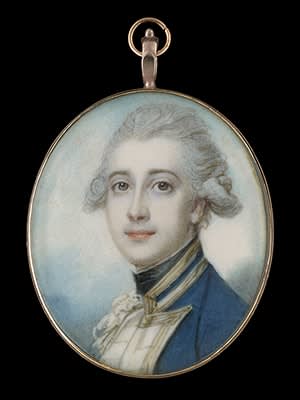
Richard Cosway
Portrait miniature of a naval captain, possibly Sir Charles Edmund Nugent (bap.1759-1844), wearing blue naval uniform with white facings and gold lace, his hair powdered, sky background, c. 1790
Watercolour on ivory
Oval, 48mm (1 7/8 in) high
Philip Mould & Co.
To view all current artworks for sale visit philipmould.com Sir Charles Edmund Nugent’s naval career was a distinguished one, despite his unpromising start in life as the illegitimate son of...
To view all current artworks for sale visit philipmould.com
Sir Charles Edmund Nugent’s naval career was a distinguished one, despite his unpromising start in life as the illegitimate son of an army officer. Around twelve years of age he joined the navy, possibility out of necessity as this was the year that his father died. His first posting was on the Trident serving under Sir Peter Parker. In 1775, again under Parker’s command, he served on board the Bristol in American waters.
After a period back in England, Nugent again joined Parker in 1778 when he sailed to the West Indies. Still a youth, Nugent must have made an impression on Parker who appointed him commander. The following year he was made a captain. His bravery and initiative were noted during the seizure of Omoa, a wealthy coastal port on Roatan Island.
In 1782 Nugent again returned to England and became MP for Buckingham. If it does indeed represent Nugent, this portrait may have been painted in 1790 when he married Deborah Charlotte Johnstone, widow of the politician George Johnstone, with whom he had one daughter.
In 1793 Nugent was back once again the West Indies, serving with Sir John Jervis. In 1797 he was promoted rear-admiral and then vice-admiral in 1801. After some time on half pay, exhausted by his active service at sea, he became a full admiral in 1808. At his death in 1844, he was the most senior admiral on the navy list, having been made admiral of the fleet more than ten years earlier in 1833.
Sir Charles Edmund Nugent’s naval career was a distinguished one, despite his unpromising start in life as the illegitimate son of an army officer. Around twelve years of age he joined the navy, possibility out of necessity as this was the year that his father died. His first posting was on the Trident serving under Sir Peter Parker. In 1775, again under Parker’s command, he served on board the Bristol in American waters.
After a period back in England, Nugent again joined Parker in 1778 when he sailed to the West Indies. Still a youth, Nugent must have made an impression on Parker who appointed him commander. The following year he was made a captain. His bravery and initiative were noted during the seizure of Omoa, a wealthy coastal port on Roatan Island.
In 1782 Nugent again returned to England and became MP for Buckingham. If it does indeed represent Nugent, this portrait may have been painted in 1790 when he married Deborah Charlotte Johnstone, widow of the politician George Johnstone, with whom he had one daughter.
In 1793 Nugent was back once again the West Indies, serving with Sir John Jervis. In 1797 he was promoted rear-admiral and then vice-admiral in 1801. After some time on half pay, exhausted by his active service at sea, he became a full admiral in 1808. At his death in 1844, he was the most senior admiral on the navy list, having been made admiral of the fleet more than ten years earlier in 1833.